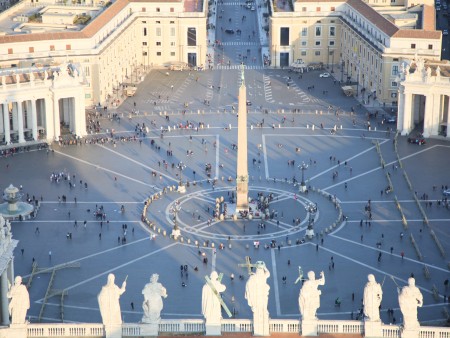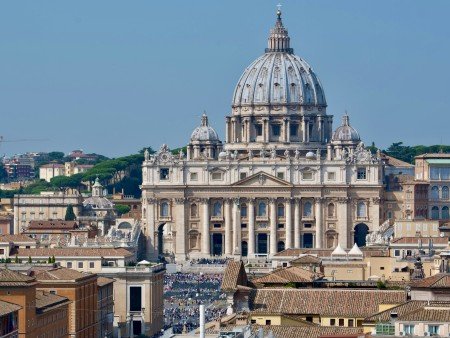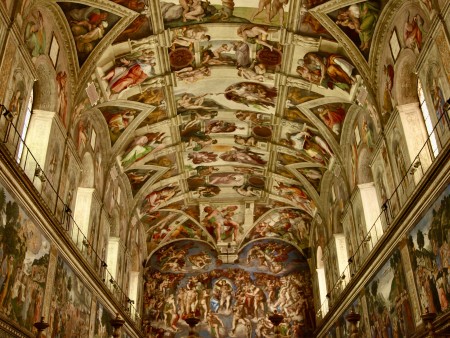Experience history and culture in Vatican's VIP residences: Castel Sant'Angelo and Villa Farnesina
Explore Frescoes & Climb the Iconic Castle: Appreciate Renaissance Art and Architecture Wonders unknown to most
Unveil Rome's Exquisite Wonders: Unparalleled Panoramas and Hidden Gems
Uncover the Eternal City's most exclusive treasures, where breathtaking panoramic views intertwine with captivating historical narratives.
Delve into the intricate and layered architecture of Castel Sant'Angelo.
Originally a towering mausoleum for Emperor Hadrian (2nd century AD) and his family, it was later transformed into a formidable fortress and then a luxurious papal residence. Ascend to the summit to discover magnificent frescoed halls and a circular portico offering an eagle-eyed view of Rome, encompassing St. Peter's immense dome and the Tiber River.
With our guide, the intricate architectural complex of Castel Sant'Angelo, will reveal the essence of Rome's history. The collapse of the Roman Empire, evident from the 6th century AD, led to the ruin of most ancient structures. However, the most impressive ones, like Castel Sant'Angelo, continued to be used, albeit for completely new purposes, unthinkable a few centuries earlier, but functional to the reduced size and importance of Rome in the new medieval political landscape.
Embrace the splendor: explore the enchanting Villa Farnesina
Wander through the expansive and luxurious halls of Villa Farnesina, one of the most magnificent Renaissance residences in Italy. Immerse yourself in the beauty and vibrancy of the grand halls with extensive frescoes adorning the walls and ceilings, masterfully created by Raphael and his students. Marvel at the harmonious blend of architecture, art, and nature that characterises Villa Farnesina, a true testimony of the Renaissance spirit.
Be captivated by the sensual stories depicted within the villa's walls, echoing the tragic love affair between its owner, Agostino Chigi, the wealthiest banker in Europe, and Francesca Ordeaschi, a noble courtesan (women of contested reputation, admired for their elegance and associated with the high and lascivious pleasures of the elite).
Explore and absorb the allure of these remarkable residences, delving into the historical, political, and economic context that shaped them for an unforgettable and humanely enriching journey.
NOTE: Under new rules, Castel Sant'Angelo tickets must have the full name of every visitor.
Group tour
11 max.
Main sites Explored in the Tour
itinerary
Opening hours and Entry Tickets for this tour
The entry tickets for Villa Farnesina are included in the cost of the tour and pre-booked by our office
The entry tickets for Castel Sant'Angelo are included in the cost of the tour and pre-booked by our office
Famous people's stories
highlights
Learning and Experiencing Goals
hidden gems
Escape the tourist traps: Immerse yourself in the timeless beauty of the frescoes at Villa Farnesina and the unmatched panoramic views of Castel Sant'Angelo.
At Castel Sant'Angelo, you'll experience history like never before with our local guide. The building has been standing for almost two thousand years and it's a stunning example of the different periods of Roman history.
It started out as a mausoleum (a really big tomb) for the emperor Hadrian. It's a huge cylindrical structure that was built to show how great the philosopher emperor was. Within the heart of the mausoleum, in its most inaccessible core, his ashes lay. So little of him remained, yet all the more would men have to toil to make his memory immense. The mausoleum did its part admirably.
Walk through the heart of Castel Sant'Angelo with our knowledgeable local guide. Explore the depths of the mausoleum and discover the secrets hidden within its walls. Journey to the Courtyard of the Angel, the center of the fortress during its military use, and stand where Rome's history was made.
Ascend further to the magnificent papal apartments, built by the popes atop the original structure, with a portico running along the entire circumference and stunning views. Reach the summit, the Terrace of the Angel, where Rome converses with the clouds, and the 360° sunsets are endless, perfect, and unmissable.
As you enter Villa Farnesina, you will feel like one of the guests at a Renaissance banquet, one of those cold winter days in 1509 when Michelangelo had been working on the Sistine Chapel for a few months and his friend, Pope Julius II, who was paying for the work, had not yet received permission from the master to take a look.
During the evenings of that cold winter at Villa Farnesina, the most exclusive and talked-about parties of the time are held, featuring luxurious dinners, gala attire, exquisite dishes, vintage wine, accompanied by music and dance. All of this is offered by the owner of the Villa, Agostino Chigi, the wealthiest banker in Europe.
At that time, the banker had already begun a relationship with Francesca Ordeaschi, also known as Imperia, a courtesan of great beauty and culture, and was very influential in 16th century Rome. With our local expert, you will be able to focus on the life of Imperia and the intrinsic ambiguity of courtesans, considered both women of easy virtue (cultured and high-class prostitutes?!) and women of remarkable beauty and intelligence admired and respected for their talent as skilled conversationalists and muses of great artists.
As for the relationship between Agostino and Imperia, we know that it was a true love story, and not only because they had a daughter, Lucrezia, born in 1511, only a year before Imperia died at the age of only 26. But her premature death left Agostino, who was 46 at the time, in deep pain, as evidenced by multiple sources from the time.
It was a great love because the banker wanted it to last forever in the magnificent frescoes of the Villa that you will admire: the sea nymph Galatea of Greek myths, represented in Raphael's masterpiece "The Triumph of Galatea", has the face, hair, grace, and beauty of Imperia, as well as in another fresco of the villa.
Your experience of the large fresco of Cupid and Psyche that covers the ceiling of the main hall will be equally intense and evocative. It is an extraordinarily luxurious and exuberant Renaissance masterpiece. Its impressive size (6m x 4m) seems to almost open up the ceiling, transporting us into the turbulent events of the relationship between Psyche, a beautiful mortal girl, and the god Cupid, obviously immortal. Their story culminates in the sumptuous wedding banquet of Cupid and Psyche, attended by all the gods, with a table inevitably dripping with wonders.
lexicon.1099
lexicon.1100
By submitting this form I agree to the processing of my personal data as indicated in the privacy policy









